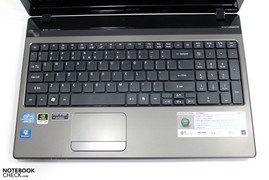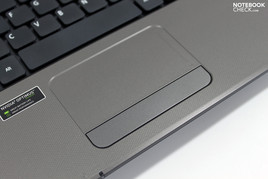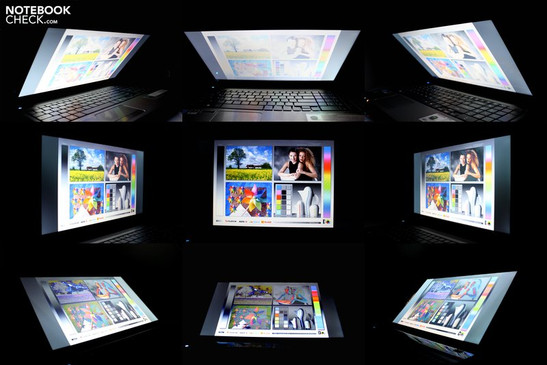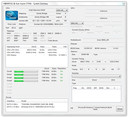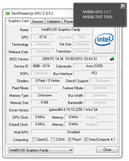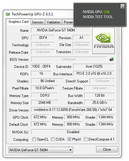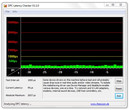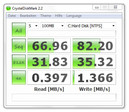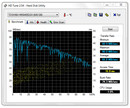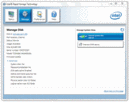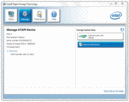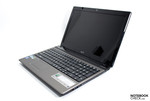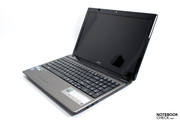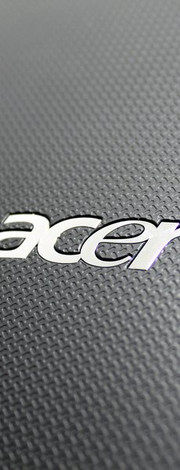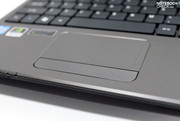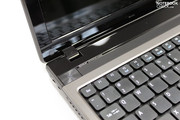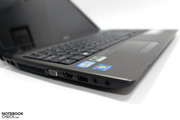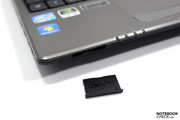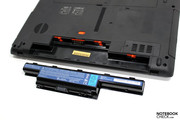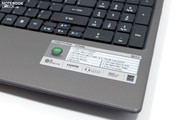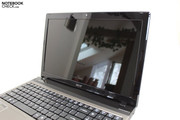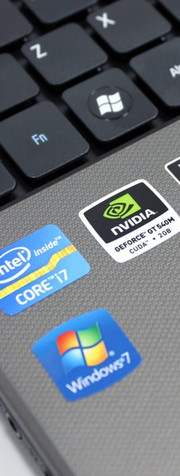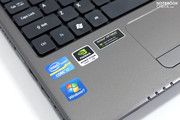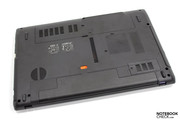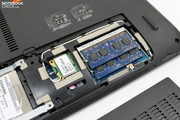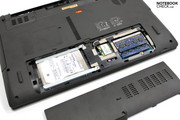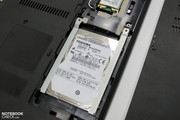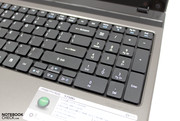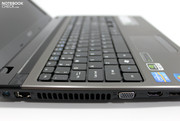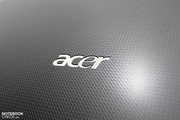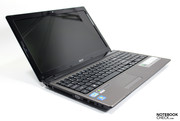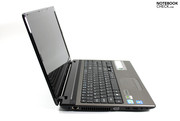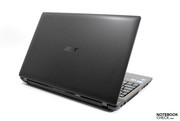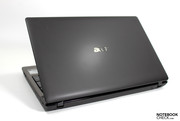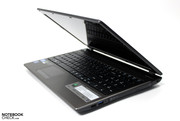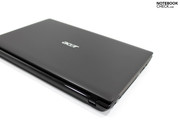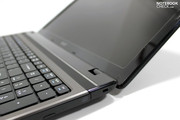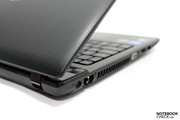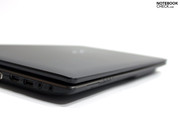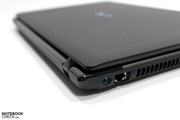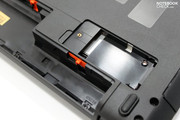Review Acer Aspire 5750G Notebook

The i7-2630QM quad core CPU from Intel makes its debut in an attractively priced system. Paired with Nvidia's GT 540M graphics card, the Aspire 5750G promises to have a remarkable application and gaming performance – and that for less than 1000 euros.
That Intel has made a leap forward with Sandy Bridge in regards to the chip's performance reserves is no longer a secret. There wouldn't be many reasons for sticking to the Clarksfield range since the new processors have the same price tag as their predecessors and have become even more efficient in terms of power consumption. That is, if Intel hadn't had a little mishap.
It can come to delays in delivery of the reviewed notebook due to the current problems of Intel's Sandy Bridge chipset. Further details and continually updated information about the situation can be found here.
We were provided with a model not intended for retail for our review. However, it will hardly differ from the purchasable consumer system.
Case
The recently reviewed Acer Aspire 5742G could soonest be named as the present Aspire 5750G's predecessor. It was also equipped with a GT 540M graphics card, but was still based on an Arrandale dual core CPU. Acer has revised the notebook's exterior, which is now slightly modified in comparison.
The slight protrusion of the display on the base unit, which separates both components optically, has been maintained. Matt, ribbed plastic is still used for the display lid and wrist-rest, which is quite compliant with the corrugated haptics. In contrast to some high-gloss machines, you can be content with low smudging susceptibility here, as well. However, dust particles and fingerprints gather around the display and on the glossy coated bar above the keyboard.
Although only plastic is used as the surface active material, it can impress us in terms of stability. The 5750G remains unimpressed by selective pressure on the chassis. Even the display lid hardly allows pressure to be transferred to the sensitive screen. The base unit's torsional stiffness is just as good. The notebook can be picked up at the front edge without any perceptible twisting or creaking noises. The display doesn't do quite as well in this exercise.
Both display hinges allow a single-handed opening and closing of the display. Nevertheless, they can't completely prevent the screen from teetering. There is no closure system for transportation. The display tends to open when the notebook is held upside down. In other words the tension force is too low. Consequently, you have to take care that nothing can slip into the gap and possibly cause massive damage, especially when transporting the laptop.
Connectivity
A glance at the 5750G's interface positioning reveals the modifications on the case. The fact that the LAN port has been moved next to the power socket in the left back corner is agreeable. However, VGA, HDMI, USB and both audio sockets are still in the front area. Lefties will have to struggle with obstructing cables beside the notebook when these ports are in use. The laptop's right doesn't look much better. Two USB ports, one of which is a USB 3.0, have also been placed in the front area. It's okay when a USB stick is plugged in temporarily, but unpleasant when devices are permanently connected (printer, mouse, etc.). The rear is completely free of ports. A SD cardreader (5in1) can be inserted into the front.
In contrast to the predecessor, the user gains a fast USB 3.0 port, which especially pays off when external memory solutions are used. The suboptimal distribution of the single ports has been maintained, albeit it has been only defused a bit by relocating the network socket. You still have to live without an ExpressCard slot to retrofit various features.
The hard disk's and RAM's position are the same as in the predecessor. The cover can be opened after removing two screws and the user can access the components. An intended upgrade doesn't seem to be a problem in this regard.
Communication
The Acer Aspire 5750G delivers the current standards in terms of communication. The wireless network connection, via Atheros Wireless Network Adapter (b/g/n) or cabled via the RJ45 port and Broadcom NetLink Gigabit Ethernet module belong to this. Also installed: Bluetooth 3.0 for communicating with various peripherals.
Supplies & Warranty
There weren't any supplies worth mentioning in the box of our device not intended for retail. This isn't very surprising, as the predecessor also didn't have much included. This however doesn't apply for the installation, where quite a bit of superfluous software can be found. For example, the trial version of McAfee's virus scanner or Norton's online backup trial version can be named. If you're not sure about these functions or already have found a virus scanner you trust, it's recommendable to uninstall these tools.
The predecessor's (5742G) warranty period is 2 years with bring-in service. We presume that the present notebook is also granted a 24 month warranty. In fact, the first shops also list the notebook with a 24 month bring-in service, one of which is a 1 year International Traveler's Warranty.
Input Devices
Keyboard
Acer likely still uses the same unit as the keyboard that was found in the predecessor. However, our test device was delivered with an English language keyboard (QWERTY), which is also the reason for the single-rowed enter key. You may deduce that the German retail devices will equal the keyboard of the Aspire 5742G in regards to key layout.
The typing feel leaves us with mixed feelings, just like its predecessor. On the one hand, the separated chiclet design (capped keys, evident gaps) bids a clearly palpable pressure point and a pleasant key drop. Nevertheless, the feedback proves to be somewhat impartial. The reason for this is that the keys tend to tilt at their edges and, beyond that they haven't been made absolutely even. Thus, it makes it difficult for the fingers to palpate the key center for an optimal feedback. It could also prove to be difficult to clean the key gaps.
The number pad adjacent to the keyboard has to be mentioned positively. It facilitates entering numbers and can also be helpful in various applications and games. In return, you have to accept restrictions at the arrow keys, which have turned out very small (only about 50% of a standard key). They frequently aren't triggered properly in practical use.
Touchpad
Acer likely has also used a familiar unit for the touchpad. The surface is very smooth in contrast to the surrounding materials and allows the finger to glide pleasantly over it. In addition, the vertical scroll field on the right edge has been haptically marked. The multi-touch pad doesn't have to take reproach in terms of response.
The linked key bar can be pressed with well dosed force on its edges and emits a pleasant click noise. We weren't as convinced from the dead zone in the key bar's middle third. Here an action is only possible with an especially high force, if at all.
Display
The used screen is a LGD0250 display with a maximum resolution of 1366x768 pixels. Thus, a different display is used in the 5750G than in the Aspire 5742G. However, according to its key data, it plays in the same league. Nothing has changed in terms of the reflective glare type surface or in the resolution. It suffices for average multimedia and office use. But the limits of overview are soon reached when you work with programs containing numerous toolbars (video, image editing) or even with several windows at the same time.
Let's look at the installed display's determined rates. The screen can't reach the unit built into the predecessor that generally provided a higher brightness and also played in a higher league in terms of illumination. Our present display has a maximum brightness of 205 cd/m2 in the center area that decreases to 170.6 cd/m2 at the edges. The display can't really convince with a maximum contrast of 161:1 either, and remains among the majority of budget office and multimedia notebooks.
| |||||||||||||||||||||||||
Brightness Distribution: 83 %
Center on Battery: 205 cd/m²
Contrast: 161:1 (Black: 1.27 cd/m²)
49.84% AdobeRGB 1998 (Argyll 3D)
72.6% sRGB (Argyll 3D)
48.24% Display P3 (Argyll 3D)
The reproducible color spectrum also confirms that the installed screen is only average hardware. Adobe RGB, as well as sRGB, remains unreached. In comparison, the display is on par with cheaper notebooks, such as the MSI CX620. This isn't actually important for the average consumer. However, ambitioned graphic designer and image editor enthusiasts will likely see this as a reason for exclusion.
With a weight of 2.5 kilograms the Aspire 5750G would basically still be mobile enough for you to take along. However, the display restricts this mobility significantly. The interplay of moderated display contrast and brightness, as well as the reflective surface make outdoor use almost impossible. We already struggle with intense reflections indoors. This effect practically prevents the notebook from being used outdoors.
The viewing angle stability also doesn't count to the installed display's strengths. Increasing massive image changes already turn up vertically at the slightest deviations from the ideal, perpendicular viewing angle. On the other hand, reflections get more intense horizontally and increasingly dim the display content's legibility.
Performance
We could already observe the remarkable performance increase of Intel's Sandy Bridge in comparison to its Clarksfield predecessors in previous reviews. The consumer benefits from it insofar that Intel has left the prices for the new chips on the level of their predecessors and the performance gain doesn't have to be paid for with a surcharge.
Acer installs an i7-2630QM CPU in the Aspire 5750G. This is interesting because quad cores from the Clarksfield range were only found in bulky gaming and DTR notebooks until now. The native quad cores now appear to have moved into the notebook midrange due to their particularly attractively priced 2630QM chip. There were/are a few laptops listed in a price range around 1000 euros with this processor.
Acer relies on a representative of the latest Nvidia generation for the graphics card, the GT540M. Equipped with DirectX11 support and numerous features, it presents a comprehensible choice for an inexpensive all-round device. Beyond that, the Intel HD Graphics 3000 incorporated in the CPU is also used due to Nvidia's Optimus. Optimus switches to the best adapted GPU for every case fully automatically and without the user noticing it. Thus, the integrated graphics solution is called upon in low load and the GT 540M when graphics power is needed. That reduces the laptop's power consumption, as well as the emissions during office use.
We were particularly curious about how the present Aspire 5750G would stand out from its predecessor, 5742G, with an Arrandale CPU and the same graphics card in our benchmark tests. Does the graphics card also benefit from the support given by the Sandy Bridge processor? The Nvidia GT 540M GPU was permanently enabled for the following tests.
CPU Performance
Cinebench R10's benchmark test is still viable for rating the CPU's performance. It differs between the utilization of one single core and all parallel calculating operations available (8). The Acer Aspire 5750G with the i7-2630QM CPU at hand achieves good 4589 points in the single core test. This rate is within the expected range of similarly equipped notebooks (Fragbook DTX: 4610 points, Aspire 7750G: 4589 points). In comparison to the predecessor chips from Intel, it is on par with an i7-640M Arrandale CPU.
The Sandy Bridge CPU can show its full potential in the multi core test: 16851 points are within the expected range of previously tested, equally designed processors on the one hand. In comparison to the Clarksfield quad core processors, the 2630QM can even excel an i7-940XM CPU that reached a maximum of 14120 points (mySN XMG8.c) on the other. This result is even more remarkable if you consider that this CPU still had a price of about 1000 dollars a few weeks ago and that it was the strongest solution on the market.
Our test system achieves just as an inconspicuous, yet again respectable result in comparison to the "old" core "I" chips, with 4.9 points in the Cinebench R11.5 CPU test. Even the i7-940XM lags behind evidently with up to 4.1 points. The i7-640M (dual core) with up to 2.6 points is surpassed by almost two times. Further details and extensive benchmark tests about the new Sandy Bridge quad core processors can be found in our special.
PCMark Vantage's benchmark test provides evaluations about the entire system performance. Our test system can reach 7777 points here. This score is also within the expected range considering the installed hardware. The Acer Aspire 5750G thus generally plays in the upper league of office machines, such as the HP Elitebook 8540w (620M, FX880M) or the Dell Latitude E6510 (820 QM, NVS3100M). Merely laptops with a solid state drive (SSD) can surpass this with around 10000 points. Configurations with a conventional hard disk and without a Sandy Bridge CPU can't keep up here.
| PCMark Vantage Result | 7777 points | |
Help | ||
GPU Performance
The Geforce GT 540M from Nvidia can be classified as a midrange graphics card that we will primarily find in low-priced all-rounders. The GPU previously showed its performance reserves in the review of the Asus N53SV and leaves the ATI HD5650, for example, behind in most exercises. Detailed gaming benchmarks about this GPU can be found in this test, as well as on our page with details about the GT 540M GPU.
Our Acer Aspire 5750G test system achieves 8011 points (1280x1024) in the 3DMark 2006 benchmark test. Thus the notebook is in the midfield of previously reviewed laptops with an identical GPU, behind the Asus N53SV with 2720QM (8423 points), but still clearly in front of the Acer 5742G with an i5-450M CPU. Previous gaming machines, the like of a Toshiba Qosmio X500 with a GTS 250M GPU or an Acer Aspire 7745G with AMD HD5850 graphics, are located at a similar ranking.
4388 points can be achieved in the latest 3DMark Vantage (performance test). The Acer 5750G is almost on par with the Asus N53SV (4458 points). The Aspire 5742G with an Intel Core i5-450M CPU lags behind a bit with 3785 points. Thus, the GT 540M graphics places itself slightly beneath the GTX 260M GPU that still belonged to the high-end category about a year ago. An ATI/AMD HD5730 clearly lags behind with up to 3829 points. The HD 5850 should still be in the lead.
We also have the latest version of the well-known 3DMark range available with 3DMark 11. With a performance score of 989 points, the Sandy Bridge test system only slightly surpasses the Arrandale predecessor (958 points). Interesting: AMD's midfield player, HD5650, can keep its lead, tested in the Acer Travelmate 7740G, with 1024 points. This also applies to its successor, HD 6550M, which clearly has the lead in both the Aspire Timeline 4820TG with 1107 points, as well as in the smaller 3820TG with 1100 points.
These results show the great (positive) impact of the strong Sandy Bridge CPU, which evidently beefs up the installed GT 540M's performance in older GPU benchmarks a bit.
| 3DMark 06 Standard Score | 8011 points | |
| 3DMark Vantage P Result | 4388 points | |
| 3DMark 11 Performance | 989 points | |
Help | ||
There won't be a way around a conventional hard disk at a retail price of clearly below 1000 euros. Even cheap SSDs with a capacity of 80 GB still cost about 200 euros. This would actually represent the absolute minimum limit in terms of a reasonable capacity with only one installed data carrier in the laptop. Back to the installed rotating memory. Acer trusts a device from Toshiba here. In detail, it's a MK6465GSX with a gross capacity of 640GB at a rotation speed of 5400 rpm.
HDTune rewards the memory medium with throughout attractive rates, which are an average transfer rate of 66.8 MB/s and an access time of 16.8 MB/s. CrystalDiskMark also shows acceptable rates, apart from the 4K random read test, which remains slightly below expectations with 0.397 MB/s.
In view of the current problems with Intel's Cougar Point chipset, we can partly give the all clear for the Aspire 5750G. The Intel Rapid Storage Tool allocates the installed hard disk to port 0, thus the not affected 6G port. Merely the optical drive (port 2) might be affected by a possible port failure. This problem should however be remedied by the time the Acer Aspire 5750G is back in retail.
As known, the gaming performance is primarily dependent on the installed graphics unit. Beyond that, the CPU can also be responsible for a slight frame rate improvement, or even be the cause for the one or other missing frame rate, depending on the single game and the selected graphic details.
We've had a few laptops with a GT540M in review. So, we will only check if the given performance is within the expected range with a row of benchmarks. You can find further information and detailed benchmarks either on our page with details about the Nvidia Geforce GT 540M or in our game comparison of mobile graphic cards.
Colin McRae: DIRT 2
The Acer Aspire 5750G achieves an average of 30.1 fps in the race game's incorporated benchmark test with high details (1366x768, high, 2xAA). Thus, the notebook slightly lags behind the Asus N53SV with a 2720QM. Overall, the GT540M places itself on a level with the GT 335M (Dell XPS15).
| Colin McRae: DIRT 2 | |||
| Resolution | Settings | Value | |
| 1360x768 | High Preset, 2xAA | 30.1 fps | |
| 1024x768 | Medium Preset, 0xAA | 68.9 fps | |
Mafia 2
If it were up to Mafia 2, the Acer Aspire 5750G would have the lead in comparison to the similarly equipped Asus N53SV, with the stronger 2720QM, though. The Asus is clearly topped with an average of 34.8 fps in the game built-in benchmark test set to high (1366x768, high, 16xAF). Even the HD 6550 in the Aspire Timeline 4820TG lags behind with 32.8 fps. The GT 445M in Dell's XPS 17 can keep the lead slightly with 41.8 fps.
| Mafia 2 | |||
| Resolution | Settings | Value | |
| 1360x768 | high, 0xAA, 16xAF | 38.1 fps | |
| 1024x768 | medium, 0xAA, 8xAF | 41.9 fps | |
| 800x600 | low, 0xAA, 0xAF | 50.9 fps | |
Unigine Heaven 2.1
This is a benchmark that in particular checks the DirectX11 features of a GPU. Our Acer 5750G test system reaches an average of 13.3 fps here and thus practically stays on par with the Asus N53SV or the Aspire 5742G with the same GPU. They are followed by the GT 425M GPU from Nvidia as well as the HD 6550 in the 480TG, or the widely distributed HD 5650. Nvidia has evidently gained ground in terms of DirectX11, after placing itself on par with AMD quite late.
| Unigine Heaven 2.1 | |||
| Resolution | Settings | Value | |
| 1280x1024 | high, Tesselation (normal), DirectX11, offAA, 1xAF | 13.3 fps | |
Verdict: Gaming Performance
Basically, we can agree with the earlier conclusions of test systems with Nvidia's Geforce GT 540M. Nvidia bids a strong midrange graphics card that proves to have enough performance reserves to supply smooth frame rates in high details even in most current games. AMD's HD5650 or HD6550 can even partly be surpassed marginally, whereas each and every game or benchmark will sometimes prefer the one and sometimes the other graphic solution.
Ultimately, the individually used driver also plays a significant role for performance. For example, we received our test system with the Nvidia 285.xx graphics driver which resulted in repeated crashes (for example, the graphics driver failed at the start of Crysis). All benchmarks and gaming tests ran without problems after updating it to 266.58. You can find the latest graphic drivers on Nvidia's homepage.
| low | med. | high | ultra | |
|---|---|---|---|---|
| Counter-Strike Source (2004) | 150 | |||
| Half Life 2 - Lost Coast Benchmark (2005) | 185.8 | |||
| World in Conflict - Benchmark (2007) | 167 | 40 | ||
| Crysis - GPU Benchmark (2007) | 30 | |||
| Crysis - CPU Benchmark (2007) | 28 | |||
| GTA IV - Grand Theft Auto (2008) | 64.3 | 63.1 | ||
| F.E.A.R. 2 (2009) | 77 | |||
| Colin McRae: DIRT 2 (2009) | 68.9 | 30.1 | ||
| Mafia 2 (2010) | 50.9 | 41.9 | 38.1 |
Emissions
System Noise
The Acer Aspire 5750G surprised us pleasantly with its fan activity. It remains completely disabled or only increased to its lowest level in idle mode, respectively with only low office load. The 5750G owes its incomplete silence to the installed hard disk. Its operating noise was always present and thus shows itself responsible for an assessed rate of 32.3 dB (A). Nevertheless, if you consider that we are dealing with a compact 15 inch device with a slim case in which a quad core does its work, this is more than acceptable. The Optimus Technology likely contributes a significant part to this, as it disables the GT 540M GPU completely when it's not needed.
When the device's main components are loaded (CPU, GPU), the noise level increases to an acceptable 38.2 dB(A). This is also the noise level recorded during gaming, which is still manageable in an according soundscape. Our stress test (CPU and GPU loaded to 100%) can yet tickle even a bit more out of the Aspire 5750G. We can measure a maximum of 40.1 dB(A), which still isn't a reason for worry.
Noise level
| Idle |
| 32.3 / 32.3 / 33.6 dB(A) |
| HDD |
| 32.6 dB(A) |
| DVD |
| 35.2 / dB(A) |
| Load |
| 38.2 / 40.1 dB(A) |
 | ||
30 dB silent 40 dB(A) audible 50 dB(A) loud |
||
min: | ||
Temperature
It becomes obvious when looking at our surface temperature measurements that the powerful hardware installed actually does have an impact on the Aspire 5750G. We measure up to 35.4°C on the base unit's top and up to 38.1°C on the bottom, both take in the wrist-rest's area after only one hour without load (idle). This isn't a problem for use, but the hands perceive this heating quite clearly.
The notebook spat fire, at least when we look at our temperature graph, in the stress test. We observed a maximum of 49.2°C on the top's center keyboard area, whilst the bottom even reached a maximum of 52.6°C. This illustrates the span between the installed hardware's excellent energy savings features without load and yet extreme performance reserves that we extracted in the stress test, which left the according traces. Traces were also left by the stress test inside the case. Here the CPU skyrocketed up to 96°C and the GPU didn't exactly keep a cool head either with up to 93°C.
When we only put the CPU under load in one core/thread (SuperPi, Cinebench Single), Coretemp could record a maximum clock rate of up to 2.8 GHz, but it usually was in the area of 2.7 GHz. This is a bit less than Intel's specifications would allow for this chip (2.9 GHz). The recorded rate was 2.6 GHz when all threads were loaded (Cinebench Multi). Both rates were however measured in the device's cold state. A 3DMark 2006 benchmark test executed immediately after our stress test showed a slightly lower result of 8852 points (1280x768) than in the device's cold state (9027 points). This could indicate performance throttling under full load over a longer period. And in fact, The CPU clock was clearly lowered with 0.8 – 1.5 GHz after about an hour stress test. The GT 540M's GPU rate remained on a stable level in return.
These limitations are rather unlikely in practical gaming because neither the GPU nor the CPU will be fully loaded for a longer period of time. Also, the fan has spare reserves in this state in form of higher rotation speeds. However, theoretical performance losses during tedious CPU calculations (rendering, converting, etc.) can't be excluded since the system obviously works at its limits in terms of temperature here.
(-) The maximum temperature on the upper side is 49.2 °C / 121 F, compared to the average of 36.9 °C / 98 F, ranging from 21.1 to 71 °C for the class Multimedia.
(-) The bottom heats up to a maximum of 52.6 °C / 127 F, compared to the average of 39.2 °C / 103 F
(±) In idle usage, the average temperature for the upper side is 32.7 °C / 91 F, compared to the device average of 31.3 °C / 88 F.
(-) The palmrests and touchpad can get very hot to the touch with a maximum of 42.2 °C / 108 F.
(-) The average temperature of the palmrest area of similar devices was 28.7 °C / 83.7 F (-13.5 °C / -24.3 F).
Speakers
The first minutes of the sound test don't present the Aspire 5750G in a good light. Muffled and quiet sounds are emitted from both speakers located above the keyboard. The quest for some kind of equalizer ultimately led us to a "Dolby setting" shortcut on the desktop. These pre-settings were apparently disabled. After turning them on and selecting the settings for music rendering, the sound quality clearly improved. Nevertheless, the Acer Aspire 5750G doesn't surpass the average of budget multimedia notebooks – too low the possible volume, too restrained the deep pitches and too reserved the overall impression during music rendering.
Battery Life
The Acer Aspire has a li ion battery with a capacity of 45 Wh. This isn't exceptionally great for a powerful multimedia device, but standard in this price range. Let's first take a look at our test device's power consumption. Our multimeter recorded just only 7.6 watts for the entire system in idle mode, so without load, selected Windows energy savings profile and minimum display brightness. A top rate when you consider that there is a quad core CPU and a strong graphics card in the laptop. The power consumption increases insignificantly up to 13.3 W with maximum brightness and enabled wireless modules.
It really gets down to business first under load. We could observe about 71.1 W in 3DMark. The GT 540M was enabled for this. In the stress test, so during GPU and CPU load, the display of our multimeter skyrocketed to 93.7 W for a short period, only to settle to about 73.5 W seconds later. This could also be an indication for throttling. The included adapter supplies a maximum of 90W and heated up accordingly to 59.1°C in the stress test.
| Off / Standby | |
| Idle | |
| Load |
|
Key:
min: | |
The analysis of the power consumption shows a big gap between the use during low load and the calling up of high performance. The assessment of the maximum battery life is also designed accordingly. The 5750G only lasted for 64 minutes in BatteryEater's Classic Test, which simulates a load scenario by the way of an OpenGL calculation. The flipside of the coin proves to be surprisingly pleasant: 414 minutes in BatteryEater's Reader's Test, so almost 7 hours, are more than satisfying for a comparatively powerful system.
The Aspire 5750G can still grab an excellent result of 315 minutes, so more than 5 hours, in practical WLAN surf mode. The mains independent runtime falls to 166 minutes for DVD rendering mode. But, a long hollywood movie should come to the end with that.
Verdict
After the first multimedia all-rounder based on Sandy Bridge (Asus N53SV), Acer was now also able to impress us in this sector. The manufacturer delivers a powerful bundle at a very attractive price of less than 1000 euros with the Aspire 5750G. Previous multimedia all-rounders will have to stand at the back of the line in terms of performance reserves.
The Aspire 5750G stays on the current level of low-priced multimedia notebooks in terms of case specific qualities, such as materials and interfaces. Matt plastic surface dominate the picture. The reflective display, which doesn't belong to the best of its kind due to the average brightness and moderate image contrast, can also be seen as a logical consequence. This is definitely a point that reflects the laptop's price.
You are well served with the Aspire 5750G in terms of application and gaming performance. Sandy Bridge provides fast calculations of CPU tasks and Nvidia's GT 540M graphics card can present even current games with a good graphic quality. Due to the Intel CPU's energy saving capacity and the Nvidia Optimus feature, controllable emissions in low load, a low power consumption and thus resulting good battery life of up to 5 hours appears realistic despite the enormous performance reserves. The installed hardware first takes its toll when the notebook is put under load and heats up the case very intensely. In this case, the battery life doesn't look as great anymore either.
Acer has basically set up a successful bundle with the Aspire 5750G, which especially stands out with an attractive performance for value ratio. Users who have demands on multimedia, but a tight budget could quite well be satisfied here.
Note: It can come to delays in delivery of the reviewed notebook due to the current problems of Intel's Sandy Bridge chipset. Further details and continually updated information about the situation can be found here.








